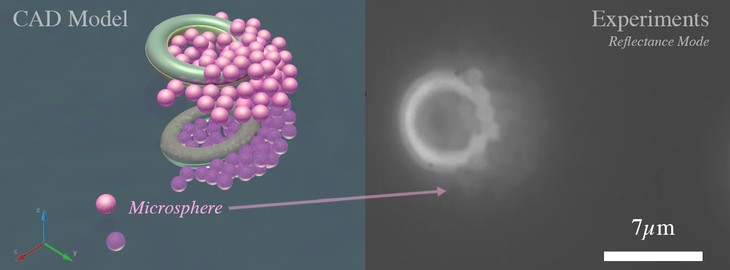
This is the view of a team of researchers from Britain, Canada, and the US who’ve overcome fabrication challenges associated with replicating biological designs that have evolved to thrive in challenging environments. Their microscopic, 3D-printed, doughnut-shaped tori are coated with nickel and platinum and could bridge the gap between biological and synthetic swimmers.
"It's really hard to get things to mix when using a lab-on-a-chip," said Remmi Danae Baker, doctoral candidate in material science and engineering, Penn State University. "These microtori, because they are active materials and move on their own, could be used to aid in micromixing."
Igor Aronson, Huck Chair Professor of Biomedical Engineering, Chemistry and Mathematics, Penn State, added that may eventually have medical applications as active materials.
Disrupting bacterial communication opens up artifical cell design
The researchers manufactured the tori using a Nanoscribe Photonic Professional GT machine that allows creation of the 3μm, 7μm or 14μm tori with printed features of up to 200nm. The Nanoscribe uses precise laser technology and specially designed photoresists to achieve this.
"We create two different designs, horizontal and vertical," Baker said in a statement. "Horizontal tori are printed flat on the supporting glass slide, glazed with nickel and then platinum. Vertical tori are 3D-printed upright and are then dipped in nickel and platinum."
According to Penn State, the nickel serves two purposes: platinum will not adhere to the plastic microtori, but nickel will. Platinum will then stick to nickel, which is magnetic, allowing the researchers to manipulate the microtori with magnetic fields.
"The lattices of the nickel and platinum layers match up pretty well," said Baker.
For the experiment, the researchers placed the microtori in a hydrogen peroxide solution, which acted as fuel. Platinum decomposes hydrogen peroxide and powers propulsion of the microtori.
"Originally, it was thought that a horizontal torus would just rise off the substrate and hover, but that doesn't happen," said Aronson. "Rather than rise straight up, they begin to tip, reach a 15° angle and then they swim like a jet skier."
While the horizontal microtori move in a straight line, Aronson noted that a vertical torus will not move in the direction of the magnetic field, but as the magnetic field increases, the torus creates larger and large flat loops until the movement becomes a straight line.
In Nature Communications the team said: "The tori also manipulated and transported other artificial swimmers, bimetallic nanorods, as well as passive colloidal particles."
The bimetallic rods are similar to bacteria and according to Penn State this is the first step to manipulating biological matter like cells and bacteria.
The researchers found several new behaviours for these 3D-printed chemically powered microswimmers. Both their experimental and modelling approaches are applicable to other microswimmers powered by alternative methods to hydrogen peroxide. For biological systems, microswimmers might use bio-compatible propulsion systems like enzymes or light.
"These biocompatible, 3D-printed microswimmers would then be able to interface and manipulate biological active matter leading to the development of intelligent cell transport and therapy,” the team noted.

Project to investigate hybrid approach to titanium manufacturing
What is this a hybrid of? Superplastic forming tends to be performed slowly as otherwise the behaviour is the hot creep that typifies hot...